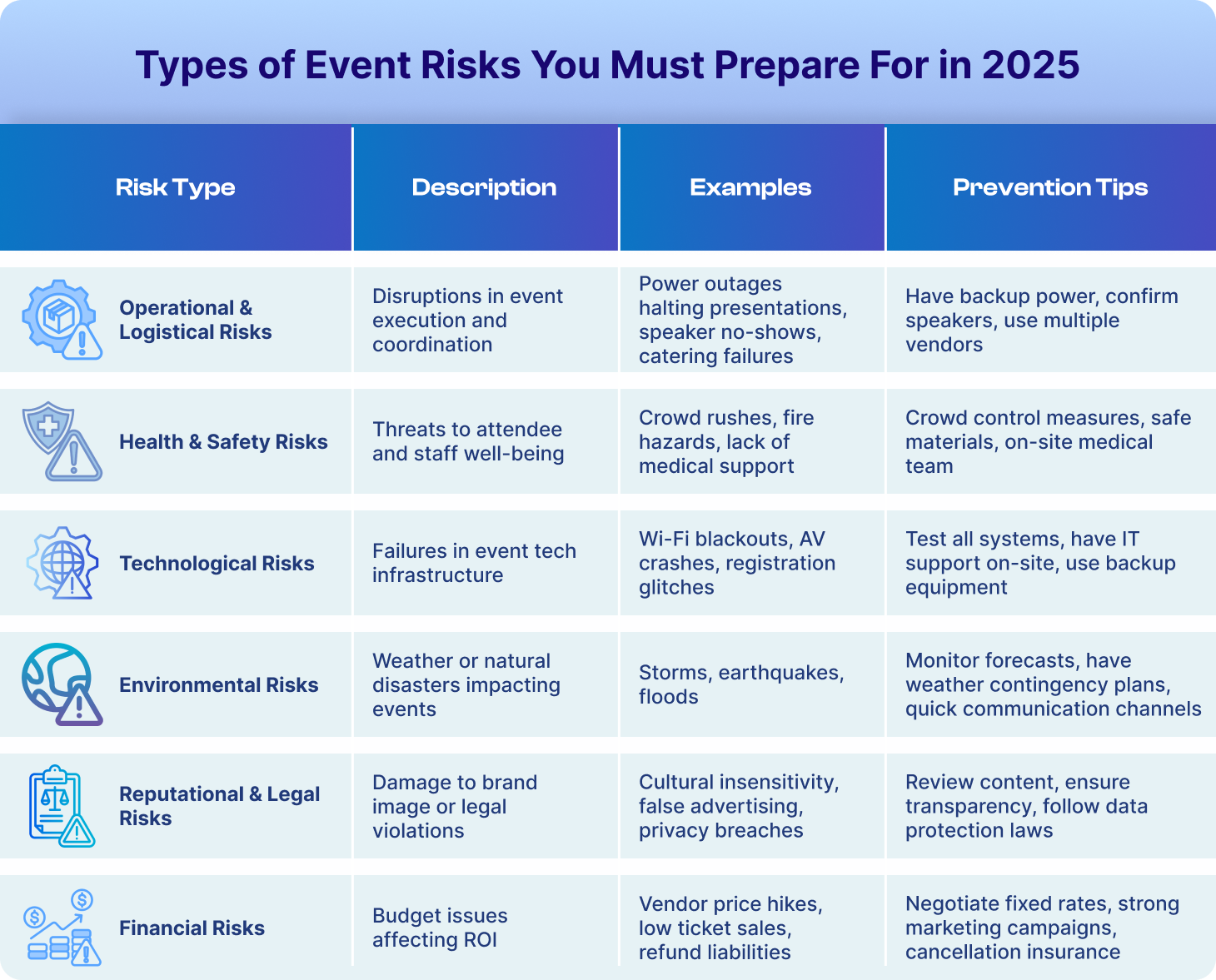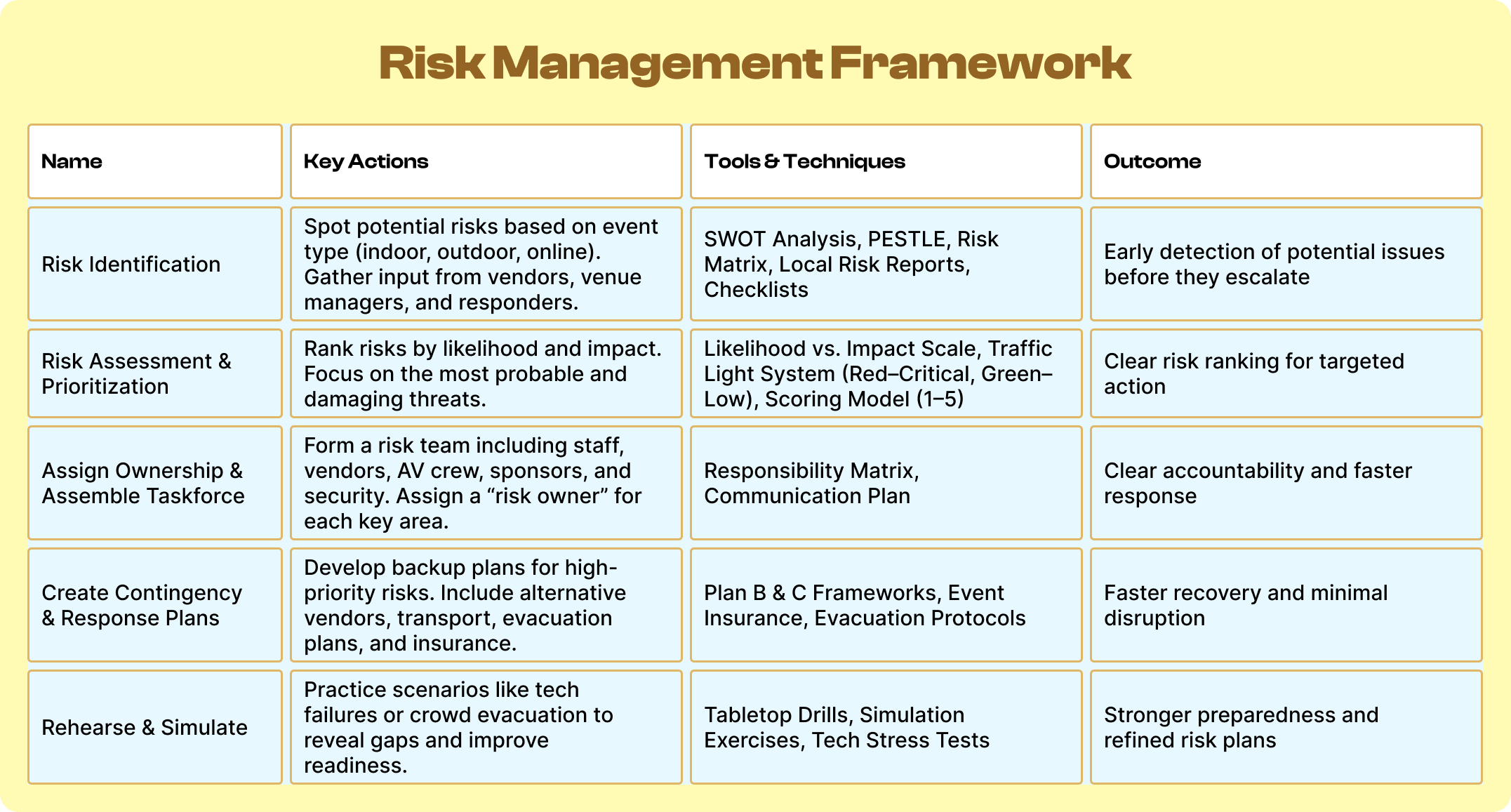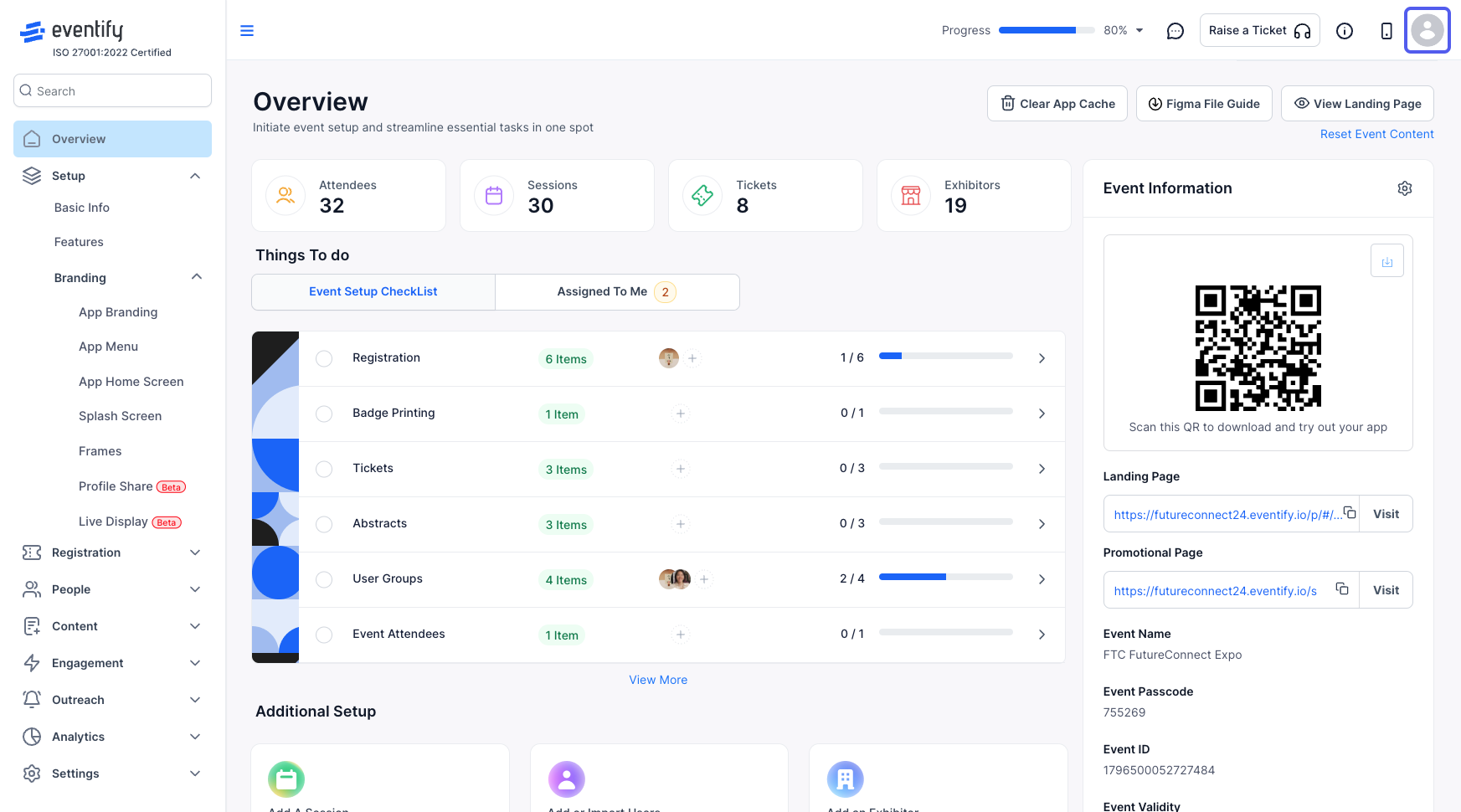From no-show keynote speakers and sudden weather shifts to data breaches or crowd safety disasters, event risks can strike unexpectedly, and at the worst possible moment.
The Astroworld tragedy was a prime example of how events could go wrong due to poor crowd control. Woodstock ’99 became a disaster due to extreme heat, inadequate planning, and a complete lack of contingency measures. Even something as ordinary as a dust storm has delayed Coachella sets. However, in that case, transparent communication saved the day.
The lesson? Significant events aren’t just built on ideas—they’re built on resilience.
That’s where event risk management comes in. It’s about assessing what could go wrong, how it might happen, and what measures you can take to prevent or respond quickly when it does.
And with today’s technology, it’s easier than ever. The right event management platform help monitor risks in real time, communicate across teams, and stay in control before, during, and after the event.
Disaster rarely sends invitations. Ask yourself: would you be ready when it shows up?
Key Takeaways
- Event risk management is proactive. It’s about planning before things go wrong, not reacting after.
- Risks come in many forms, including operational, financial, legal, reputational, environmental, and technological.
- A structured framework (identify, assess, assign, prepare, rehearse) turns chaos into control.
- Clear communication saves reputations, especially in crisis moments.
- Tools like Eventify simplify risk management with real-time dashboards, checklists, and incident tracking.
.jpg)
What Is Risk Management In Event Industry & Why Does It Matter?
Event risk management is all about preparing for any potential issues that could arise before, during, or after the event. No matter how “perfectly” you plan the execution of an event, there’s always a chance that things might go wrong.
It’s a proactive approach to identifying potential threats, assessing their likelihood and severity, and putting controls in place to prevent or respond to them.
These risks are not just about safety; they include:
- Financial risks (unexpected costs, vendor failures)
- Operational risks (technical failures, logistics breakdown)
- Reputational risks (bad press, attendee dissatisfaction)
- Legal risks (permit issues, non-compliance, data privacy breaches)
With today’s events taking place in volatile environments ranging from unpredictable weather to rapid technological changes and global health concerns, the likelihood of disruptions is significantly higher. What makes these disruptions an even more serious matter is that stakeholder confidence, attendee experience, and business continuity all rely strongly on risk management.
With event management platforms following a structured approach, such as event planning tools, trained teams, and responsive systems, it has become easier to manage risk at every stage. When done right, risk management doesn't stifle creativity; it frees planners from the worries of the unexpected so they can plan and innovate confidently.
Types of Risks At An EventYou Need to Prepare For
Now that we understand what event risk management is, the next step is recognizing what exactly you need to prepare for. Risks can take many forms, some obvious, others less so, but all of them can have serious consequences if ignored.

Operational & Logistical Risks
Operational and logistics risks are on-the-ground disruptions that affect the smooth execution of your event. These include:
- Power outages that halt presentations or stage performances
- Speaker doesn’t show up because of travel issues or double-booking
- Catering failure due to vendor miscommunication or spoilage
Health & Safety Risks
The physical well-being of attendees and staff should be your priority. Make sure you make necessary arrangements to:
- Avoid crowd rushes in poorly managed queues or exits
- Use proper material and avoid overloading circuits, which may cause fires
- Cater to medical emergencies without on-site support.
An example of a failed health and safety risk event includes Woodstock ’99, which was a musical festival held in Rome. This event was marred by logistical problems like high food and water prices, inadequate sanitation, and extreme heat, which led to widespread dissatisfaction. Apart from these, there were reports of fires and looting. Ultimately, three deaths were reported.
.jpg)
Technological Risks
Events today rely heavily on technology, and failure in this department can cause significant disruptions. Technological risks include:
- Wi-Fi blackouts during hybrid conferences
- AV system crashes during keynote speeches
- Event registration software glitches that delay check-ins
Environmental Risks
Although nature is unpredictable, it must be factored in. You will have to prepare for the extremes, like:
- Rainstorms, hailstorms, or duststorms at outdoor events
- Earthquakes or floods disrupting venue access
An example of planned environmental risks includes one of Coachella’s evening performances in 2019, where strong winds posed a safety threat. Instead of pushing through and risking equipment failure or injuries, the organizers made a proactive decision to delay the show.
Immediate updates were made across its website and social media platforms. The messages were clear and calm, explaining the reason for the delay and assuring attendees that the event would resume shortly.
Reputational & Legal Risks
Reputational and legal risks are the ones that impact your brand’s image and legal standing. Examples include:
- Cultural insensitivity in programming or decor
- False advertising leading to attendee disappointment
- Privacy breaches in attendee data handling
It is essential to handle such issues before the event begins to avoid them from escalating.
Financial Risks
Financial risks will affect your overall budget and return on investment. Hence, it is essential to plan carefully and make a backup plan in case any of the following occurs:
- Last-minute vendor price hikes
- Low ticket sales due to weak marketing
- Refund liabilities from cancellation
.jpg)
Risk Management Framework That Actually Works
Event risk management isn’t guesswork; it’s strategy. Here’s a proven, ISO-aligned framework to bring structure, speed, and clarity to the chaos.

Step 1: Risk Identification
Begin by planning what could go wrong. For indoor events, look for all indoor amenities; for outdoor events, look for weather and natural disasters; and for online events, ensure technology is top-notch.
Use tools like SWOT analysis, PESTLE (Political, Economic, Social, etc.), and a Risk Matrix to categorize risks. Tap into local risk reports, interview vendors, venue managers, and medical responders, and use checklists to surface blind spots. All of this would help you catch the cracks before they become catastrophes.
Step 2: Risk Assessment & Prioritization
Not all risks are equal. Rank them using a likelihood vs. impact scale. Assess what is most probable and what is most damaging. With risks listed using traffic light systems (red for critical and green for low-risk), scoring models (5 being riskiest and 1 being lowest risk), you will know where to focus. Prioritization ensures time and resources go to the threats that truly matter.
Step 3: Assign Ownership & Assemble a Taskforce
You can’t manage risk alone. Hence, it would be wise to build a task force that includes your core team, vendors, AV staff, sponsors, and venue security. Once you do this, assign a risk owner to each key area. The risk owner would be accountable for spotting red flags and responding fast. When everyone knows their role, tackling risks, no matter how intense, can be easy.
Step 4: Create Contingency & Response Plans
For every high-priority risk, build backup plans (Plan B, or sometimes Plan C as well). That could mean lining up backup vendors, arranging alternating transport for speakers, or making an emergency evacuation plan in case of any natural disaster. You may also go for event insurance. The better your backup plan is, the quicker you will bounce back.
Step 5: Rehearse & Simulate
Make sure whatever you plan is nicely rehearsed and simulated. Run tabletop drills, simulate tech failures, or practice crowd evacuation. These rehearsals will uncover loopholes you might not see otherwise and give your team the muscle memory to act under pressure. With each rehearsal, you can refine your plans and make your next event stronger.
%20(1).jpg)
Communication in a Crisis: Keep Everyone Informed
Even the best-laid plans can go sideways, and when they do, how you communicate and work with your team can make or break the outcome. Your team should receive updates in real-time so everyone, from vendors to volunteers, knows what’s happening and what to say.
If you make any decision or have any changes in plans, ensure public messaging is fast, transparent, and unified. Attendees should be informed about the cause of the problem and how your team is working to resolve it.
Media handling matters, too. Make sure you prepare statements in advance to avoid speculative or conflicting updates. Whether it's a sudden schedule change, safety concern, or weather delay, attendees need timely alerts and statements across multiple channels, including SMS, email, app notifications, and on-site screens.
Insurance: Your Final Safety Net
Even with the best practice and management, you might still face risks that are out of your hands. This is where insurance steps in. Insurance is your last line of defense when things go wrong. Here are the insurances you can go for:
- Public Liability Insurance: It protects you if someone gets injured or property is damaged during your event.
- Cancellation Insurance: It is a must-have for outdoor or large-scale events where weather, strikes, or sudden venue issues can derail plans.
- Medical Coverage: It ensures that emergency incidents don’t spiral into lawsuits.
- Property Insurance: It helps shield against damage or theft of equipment.
Before you finalize any insurance, make sure to carefully read all conditions, including exclusions, coverage limits, and claim conditions, as they vary widely. Do not assume anything; read and verify.
Insurance doesn’t stop things from going wrong; it makes sure they don’t take everything down with them. Don’t treat it as an afterthought. Make it part of your core planning process.
Post-Event Risk Management Evaluation
Conduct a formal after-action review within 7–14 days of the event. Doing so will help measure key metrics such as number and type of incidents, average response times, attendee satisfaction scores, vendor performance, and any near-miss situations.
With in-depth evaluation and all key-metrics carefully sturies, you can update your risk register with newly identified vulnerabilities and adjust vendor service-level agreements where needed.
Summarize findings in a short report and include the lessons learnt due to these gaps. Share this report with stakeholders to ensure improvements are implemented for future events.
Pro Tip: Within two days of your event, gather your core team for a quick 1–1.5 hour debrief. Discuss anything that almost went wrong while it’s still fresh in everyone’s minds, and note it down in a shared document. This way, nothing gets forgotten before the formal review.
How Event Management Platforms Simplify Event Risk Management
Managing event risk is no longer a scattered effort as modern event platforms bring everything into one streamlined command center.
Real-time Dashboards
.png)
These dashboards let users track risks as they evolve, monitor weather alerts, vendor check-ins, or equipment issues from one place. This means that you wouldn't have to chase updates across email threads and WhatsApp groups.
Centralized Communication Tools
.png)
Event apps have communication tools to keep everyone in sync. From sponsors and staff to vendors and venue security, you can assign roles, tag responsibilities, and send real-time alerts across multiple channels, including text, app, or email.
Ready-to-Use Templates
Such templates are used for risk assessments, safety checklists, and contingency plans, helping you save hours of paperwork while keeping you aligned with ISO-based standards.
Incident Reporting Tools
With built-in tools, you can seamlessly log what happened, track responses, and gather data to improve future events.
Tools like Eventify give you complete visibility, fast communication, and structured control, all in one place, making risk management less reactive and more proactive. You have more control, clarity, and confidence every step of the way.

Minimize Event Risk With Eventify Event Management Software
Unpredictability is the only constant when it comes to event management. While you can't control any variable, you can control how prepared you are. Proactive risk management ensures fewer surprises, faster responses, and a team that knows exactly what to do when the unexpected happens.
Don’t wait for the crisis to realize what was missing. Whether you are organizing a conference, concert, or corporate gala, Eventify equips you with the tools to anticipate, adapt, and act.
Explore how Eventify can future-proof your next event. Schedule a free consultation today.






.png)





